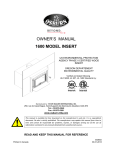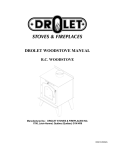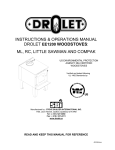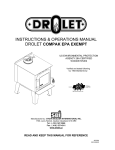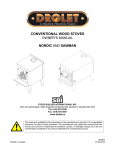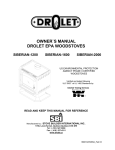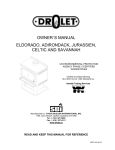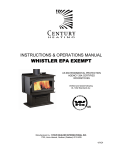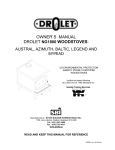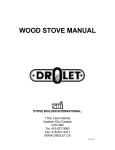Download Drolet CS1200 Specifications
Transcript
DROLET WOODSTOVE MANUAL Model 5135 ML Manufactured by : DROLET STOVES & FIREPLACES INC. 1700, Léon-Harmel, Québec (Québec) G1N 4R9 000410/45084A THE DROLET WOODSTOVE MANUAL TABLE OF CONTENTS The DROLET Woodstove Manual............................................................................... 2 Wood Heating ............................................................................................................. 2 The Controlled Combustion ........................................................................................ 2 Your Drolet Stove Assembly ....................................................................................... 3 Refractory Bricks Assembly ........................................................................................ 4 Installation Of Your Drolet Woodstove ........................................................................ 5 Positioning The Stove ............................................................................................. 5 Floor Protection ....................................................................................................... 5 Clearances .............................................................................................................. 5 Chimney .................................................................................................................. 7 Couplings ................................................................................................................ 8 Air Circulation Systems ........................................................................................... 9 Operating Your Drolet Woodstove .............................................................................. 9 Solid Fuel ................................................................................................................ 9 Before your first burn............................................................................................. 10 Ignition................................................................................................................... 11 Heating .................................................................................................................. 12 Maintenance Of The Heating System ....................................................................... 13 Maintenance Of The Woodstove ........................................................................... 13 Maintenance Of The Chimney............................................................................... 14 W A R R A N T Y ...................................................................................................... 15 1 The DROLET Woodstove Manual DROLET STOVES AND FIREPLACES INC. one of the most important woodstove and fireplace manufacturers in Canada, congratulates you on your purchase and wishes to help you get maximum satisfaction from the woodstove you have selected. In the pages that follow, we will give you advice on wood heating and controlled combustion as well as technical specifications regarding installation, operation and maintenance of the model you have chosen. The instructions pertaining to the installation of your woodstove comply with ULC S627 standards. You must follow them very carefully in order to eliminate any chance of encountering major problems. KEEP THIS INSTRUCTION MANUAL SINCE IT MAY BE VERY HELPFUL. Wood Heating Many consumers choose wood as the main or auxiliary energy source for heating their main home or secondary residence. This source of energy has the advantage of being abundant, relatively cheap and easy to store so that you are assured of energy autonomy for more of less longer periods. The Controlled Combustion The main feature of a controlled combustion woodstove is an air tightness that is the most perfect possible, and must of course be equipped with the most efficient heat exchanger possible in order to transfer maximum heat to the ambient air. It is generally doubled with firebricks, and it may have a glass door, with steel or cast iron frame. The main feature that makes it a controlled combustion woodstove remains its air tightness, which allows the user to control the quantity of oxygen admitted into the woodstove. The wood will burn slowly if the woodstove draught keys are adjusted in order to reduce the oxygen supply in the combustion chamber to minimum; on the other hand, wood will burn quickly if the draught keys are adjusted to admit a larger quantity of oxygen in the combustion chamber. 2 Your Drolet Stove Assembly 3 Refractory Bricks Assembly 4 Installation Of Your Drolet Woodstove Positioning The Stove It is very important to position the woodstove as close as possible to the chimney, and in an area that will favor the most efficient heat distribution possible throughout the house. The stove must therefore be installed in the room where the most time is spent, and in the most spacious room possible. Remember: woodstoves produce radiating heat, the heat we feel when we are close to a woodstove. A woodstove also functions by convection, that is through the displacement of hot air accelerated upwards and its replacement with cooler air. If necessary, the hot air distribution from the stove may be facilitated by a blower or the installation of floor or wall grills. Important: A woodstove must never be installed in a hallway or near a staircase, since it may block the way in case of fire or fail to respect required clearance. The woodstove must not be hooked up to a hot air distribution system since an excessive accumulation of heat may occur. Floor Protection Your woodstove should be placed on a non-combustible surface. Having these minimum specifications. Thickness of sheet 1/4" (6 mm) Front Protrusion 18" (457 mm) Side Protrusions 6" (150 mm) Rear Protrusion 6" (150 mm) Clearances It is of outmost importance that the clearances to combustible material mentioned on your woodstove certification plate be scrupulously respected upon installation. Back wall 16" (406 mm) Side wall 16" (406 mm) Corners 16" (406 mm) *Height 7' (2,3 m) * Height, from bottom of the stove to the ceiling. 5 You may decrease these clearances by installing heat radiation shields between the walls or the ceiling and the stove. These heat radiation shields must be installed permanently, and can include sheet metal, a rigid non-combustible sheet or a masonry wall. Following the installation of such a heat radiation shield, the clearances mentioned on the stove certification plate may be reduced as stated in the following table. Reductions in Clearance to a Combustible Walls (or Ceiling) and the Heating Device TYPE OF PROTECTION SIDES AND REAR\BACK TOP 67%** 50% 50% 33% 67% 50% Solid bricks, spaced 1" (25 mm) from the rear wall using fire-proof braces. 50% N\A Solid bricks, resting on sheet metal 0,013" (0,33 mm) thick spaced 1" (25 mm) from the rear wall using fire-proof braces. 67% N\A Minimal requirements: 0,013" (0,33 mm) sheet metal with 1" (25 mm) fire-proof braces Ceramic tile or an equivalent fire-proof material resting on fire-proof brackets spaced 1" (25 mm) apart by fire-proof braces Ceramic tile or an equivalent fire-proof material built on a fire-proof base resting on sheet metal of at least 0,013" (0,33 mm) thick spaced 1" (25 mm) by fireproof braces. **Example: 900 mm x (100% - 67%) = 300 mm This reduction in clearance, when in compliance, is accepted by insurance companies. 6 Chimney Your woodstove may be hooked up with a prefabricated or masonry chimney. If you are using a prefab chimney, it must comply with ULC S629 standards; therefore it must be of the 2100 °F / 650 °C. (2" / 51 mm thick insulated type). It is extremely important to install the chimney according to the manufacturer's specifications. If you are using a masonry chimney, it is important that it be built in compliance with the specifications of the National Building Code. It must be lined with firebricks, metal or clay tiles sealed together with fire cement. (Round flues are the most efficient). The interior diameter of the chimney flues must be identical to that of the stove smoke exhaust. A flue which is too small may cause draught problems, while a large flue favors rapid cooling of the gas, and hence the build-up or creosote and the risk of chimney fires. Current practice requires that the diameter of the chimney flue does not exceed the stove exhaust one by more than 30-35%. Note that it is the chimney and not the stove that creates the draught effect. Your stove's performance is directly dependent on an adequate draught from your chimney. The following recommendations may be useful for the installation of your chimney: 1) It must rise above the roof at least 3' (0,9 m) from the uppermost point of contact. 2) The chimney must exceed any part of the building or other obstruction within a 10' (3,04 m) distance by a height of 2' (0,60 m). 3) Installation of an interior chimney is always preferable to an exterior chimney. Indeed, the interior chimney will by definition be hotter than an exterior chimney, being heated up by the ambient air in the house. Therefore the gases which circulate will cool more slowly thus reducing the build-up of creosote and the risk of chimney fires. 4) The draught causes by the tendency for hot air to rise will be better with an interior chimney. 5) You must not install more than one heating unit per chimney flue. 6) Use of a fire screen at the extremity of the chimney requires regular inspection in order to insure that it is not obstructed thus blocking the draught, and it should be cleaned when necessary. 7 Couplings Once the woodstove is placed in the room in accordance with required clearances, it must be coupled to the chimney with a smoke exhaust system. Verify the clearance between your stovepipe and the surrounding combustible surfaces. If the normal 18-inch (457 mm) clearance required cannot be obtained, you may use Read and respect an insulated flue pipe or a thermal protection shield. manufacturer's instructions before installation. Coupling pipes and chimney must have the same diameter as the stove outlet. If this is not the case, contact your supplier in order to insure there will be no problem with the draught. Pipes should be made of aluminized or ordinary steel with a minimum 24 gauge thickness. Your smoke evacuation system (pipes) should be assembled in such a way that the male section of the pipes faces down. Attach each of the sections to one another with three equidistant metal screws. The pipes must be short and straight. All sections installed horizontally must slope at least 1/4 inch per foot, with the lower section toward the stove. To insure a good draught, the total length of the coupling pipe should never exceed 10 feet (3.04 m). (Except for cases of vertical installation, (cathedral-roof style) where the smoke exhaust system can be much longer and connected without problem to the chimney of the ceiling of the room). There should never be more than one 90° elbow in the smoke exhaust system. Installation of a "barometric draught stabilizer" (fireplace register) on a smoke exhaust system is prohibited. Furthermore, installation of a draught damper is not recommended. Indeed, with a controlled combustion woodstove, the draught is regulated upon intake of the combustion air in the stove and not at the exhaust. The connecting pipe must not go through ceiling, storage area, floor or any other combustible partition. 8 Air Circulation Systems In order to improve air circulation in the room where the woodstove is installed, certain options are available for specific stove models. Blower: A variable speed-control blower with a capacity of 100 CFM (2.83 m3/min) is available. Thermodisc: The thermodisc is installed on the blower's electrical supply cord, and it will start the blower when the stove temperature reaches 120°F (49oC) and cut off the power when the stove cools below 100°F (37oC). Information regarding installation of the thermodisc is included with the device. Operating Your Drolet Woodstove Solid Fuel Your heating unit is designed to burn wood only; no other materials should be burned. Wastes and other flammable materials should not be burned in your woodstove. Any type of wood may be used in your stove, but specific varieties have better energy yields than others. Please consult the following table in order to make the best possible choice. AVERAGE ENERGY YIELD OF ONE AIR DRIED CORD OF CUT WOOD High Energy Yield MBTU/cord Oak 29 Medium Energy Yield MBTU/cord Yellow birch 25 Larch (Tamarack) 23 Silver birch 22 Low Energy Yield MBTU/cord Alder 18 Spruce 17 Fir 13 MBTU/cord Sugar Maple 28 Beech MBTU/cord 26 Ash Red Maple MBTU/cord 24 23 MBTU/cord Elm 23 Douglas red fir 23 Poplar Pine MBTU/cord 17 17 Hemlock Bass MBTU/cord 17 16 Data provided by Energy, Mines and Resources - Canada 9 It is EXTREMELY IMPORTANT that you use DRY WOOD only in your woodstove. The wood must have dried for 9 to 15 months, such that the humidity content (in weight) is reduced below 20% of the weight of the log. It is very important to keep in mind that even if the wood has been cut for one, two or even more years, it is not necessarily dry, if it has been stored in poor conditions; under extreme conditions, it may even rot instead of drying. This point cannot be overstressed; the vast majority of the problems related to the operation of a woodstove is caused by the fact that the wood used was too damp or had dried in poor conditions. These problems can be: • • • • • Ignition problems. Creosote build-up causing chimney fires. Low energy yield. Blackened windows. Incomplete log combustion. Smaller pieces of wood will dry faster. All logs exceeding 6" (152 mm) should be split. The wood should be stored in a place where the grass is not too long, in such a way that prevailing winds may circulate through the fire logs. A 24" to 48" (610 mm to 1219 mm) air space should be left between each row of fire logs, which should be placed in the sunniest location possible. If the wood must be stored outside, the upper layer of wood should be protected from rain and bad weather but not the sides. Before your first burn • • • • • Check if firebricks are lined properly. If necessary, take off plastic protector from moldings. Make sure that the chimney and flue pipe are well installed according to specifications. Respect all clearances to combustibles and floor protection according to the unit you have chosen. If your not sure about the proper installation, do not hesitate to contact your Drolet dealer. 10 Ignition The installation of a log cradle is NOT RECOMMENDED in your DROLET woodstove. After making sure that the stove air intake controls are fully open, place several rumpled sheets of paper in the center of the combustion chamber. Place 8 to 10 pieces of small dry kindling wood over the paper in the form of a tent. You may also place a few pieces of heating wood, but choose them as little as possible. No chemical product (or accelerant) should be used to light the fire. Before igniting the paper and kindling wood, it is recommended that you warm up the chimney. This is done in order to avoid back draft problems often due to negative pressure in the house; cold air from the outside tends to penetrate into the house by the chimney. If such is the case, open slightly a window near the stove and twist together a few sheets of newspaper into a torch. Light up this paper torch and hold it as close as possible to the mouth of the pipe inside the combustion chamber to warm up the chimney. Once the updraft movement is initiated, you are ready to ignite the stove by lighting the paper and kindling wood inside the combustion chamber. We therefore advise you to leave the door slightly opened (a few inches) for a 5 to 10 minute period, under supervision, in order to allow for good combustion. After this time, you may close the door and progressively adjust the air controls to obtain the desired temperature. In the case of knobbed air controls, they may be closed by bringing them towards the stove. The slide controls (left-right push-pull) are closed when pushed to the left or pushed towards the back depending on the model. CAUTION: • • • • • • Do not leave the stove unattended when the door is slightly opened. When the stove is used for the first time, intense fire is prohibited in order to allow adequate cooking of the paint covering the stove and to prevent a "thermal shock" which may remove or whiten the paint. Make sure the room is well ventilated, to remove the bad odors emitted from the paint, during the first, two or three hours of using the stove and for the first three or four fire start-ups. Never heat the stove outside the house, before installation: it is then impossible to adequately monitor the combustion intensity, which provokes overheating and a thermal shock to the paint. Never use fluid or chemical products to ignite the fire. Do not burn wastes, flammable fluid such as gasoline, naphtha or motor oil. 11 Heating Once you have obtained a good bed of embers you should reload the unit. In order to do so, open the air controls to maximum a few seconds prior to opening the stove door. Then proceed by opening the door very slowly; open it one or two inches for 5 to 10 seconds, before opening it completely to increase the draught and thus eliminate the smoke which is stagnant in a state of slow combustion in the stove. Then bring the red embers to the front of the stove and reload the unit. Use only the quantity of wood required depending on the circumstances; for example, in severe cold load the stove to maximum, in milder temperatures the stove should be only half loaded. For optimal operation of your woodstove, we recommend you operate it with a wood load approximately equivalent to the height of fire bricks (this should be the maximum height of wood lead). The combustion air supply control is located above the door. The air intake is opened when the control knob is completely on the left side and closed when it is pushed towards the right. It is extremely important that you use your stove in such a way that you do not lower the temperature of the combustion gases inside the chimney too much. For this purpose, we strongly recommend that you install a magnetic thermometer on your smoke exhaust pipe, approximately 18" (457 mm) above the stove. This thermometer will indicate the temperature of your gas exhaust fumes within the smoke exhaust system. The ideal temperature for these gases is somewhere between 275° F and 500° F (135 °C and 260 °C). Below this temperature, the build-up of creosote is promoted while above 500 °F (260 °C) , heat is wasted since too large a quantity is emitted into the atmosphere. In summary, it is very easy to operate your controlled combustion woodstove, and you can prevent all potential problems by taking this advice: 1. Select a stove of adequate size: selecting a stove that is too big for the area to be heated is a common mistake. 2. Follow the installation standards scrupulously and respect the combustible material clearances for the stove, coupling pipes and the chimney. 3. Burn only dried wood, that is, with a maximum 20% humidity content; this is the most important recommendation of all. 4. Install a magnetic thermometer on your pipe, 18" (457 mm) above the stove, and maintain the temperature of your exhaust gas fumes between 275 °F and 500° F (135 °C and 260 °C). 12 Keep in mind that the most difficult months for wood heating are October and November. Indeed, during this period, the atmosphere is often very heavy and humid, and may hinder chimney draught. Moreover, the wood is often too damp, since it has not had a sufficient drying period, or it has been stored outside in the rain. Combustion problems may then occur; they are caused neither by the stove nor the chimney, but by outside factors, and will resolve themselves as the season progresses. IMPORTANT: It is important to note that wood combustion consumes ambient oxygen in the room. In the case of negative pressure, it is a good idea to allow for a fresh air intake in the room, either by opening a window slightly or by installing a fresh air intake system in an outside wall. Maintenance Of The Heating System Maintenance Of The Woodstove Slow combustion stoves are designed so that they require little maintenance: • It is wise to perform a visual inspection of the stove approximately once a month, in order to insure that no parts have been damaged, in which case repairs must be performed without delay. • It is recommend that you change the fiber ceramic seal (which makes the seal on your stove door airtight) once a year, in order to insure good control over the combustion, maximum efficiency and security. To change your airtight seal, simply remove the damaged seal, carefully clean the available surface, apply a special glue sold for this purpose, and spread the new airtight seal. You may light up your stove again approximately two hours after having completed this operation. • You should regularly dispose of the ashes, as soon as they prevent your from placing a normal load of fire logs. We recommend always leaving 1’’ (25.4 mm) of ashes in the bottom of the stove in order to insure maximum efficiency. • Always use a metal container with a lid to save the cooled ashes you remove from the stove. Make sure that there are no live embers. Moreover, it is wise to place the metal container on an insulated surface. • It is possible to give your woodstove a brand new look, by repainting it with a 1200 oF (649 o C) heat resistant paint. For this purpose, simply rub the surface to be repainted with fine sand paper, clean it properly, and apply thin coats of paint successively. Remember the advice that was given regarding new paint upon ignition of the stove because it again applies. 13 Maintenance Of The Chimney Whether you have a prefab or masonry chimney, you must conduct a visual inspection at least once a month in order to be sure that it is in good shape and that there is no excessive creosote build-up. If there is the slightest crack, or undulation of the interior or exterior surface of the chimney, repairs or replacements of defective parts must be carried out without delay. You should do at least one chimney sweeping per year, or more if your visual inspection reveals creosote deposits exceeding 1\4" (6 mm). It is important to remove all creosote, which has been detached with the sweeping brush, in order to prevent if from igniting. 14 1700, rue Léon-Harmel, Québec (Québec) G1N 4R9 tel. : (418) 527-3060 fax : (418) 527-4311 e-mail : [email protected] web site : drolet .ca LIMITED LIFETIME WARRANTY The Drolet Stoves & Fireplaces warranty extends only to the original consumer purchaser and is not transferable. This warranty covers brand new products only, which have not been altered, modified nor repaired since shipment from factory. Proof of purchase (dated bill of sale), model name and serial number must be supplied when making any warranty claim to your Drolet Stoves & Fireplaces dealer This warranty applies to normal residential use only. Damages caused by misuse, abuse, improper installation, lack of maintenance, over firing, negligence or accident during transportation are not covered by this warranty. This warranty does not cover any scratch, corrosion or discoloration caused by over firing, abrasives or chemical cleaners. Any defect or damage caused by the use of unauthorized parts or others than original parts void this warranty. An authorized qualified technician must perform the installation in accordance with the Instructions supplied with this product and all local and national building codes. Any service call related to an improper installation is not covered by this warranty. Returned products are to be shipped prepaid to Drolet Stoves & Fireplaces for investigation. If a product is found to be defective, Drolet Stoves & Fireplaces will repair or replace such defect and reasonable transportation fees will be refund. Repair work covered by the warranty, executed at the purchaser domicile by an authorized qualified technician requires the prior approval of Drolet Stoves & Fireplaces. Labour cost and repair work to the account of Drolet Stoves & Fireplaces are based on predetermined rate schedule and must not exceed the wholesale price of the replacement part. Drolet Stoves & Fireplaces at its discretion may decide to repair or replace any part or unit after inspection and investigation of the defect. Drolet Stoves & Fireplaces may, at its discretion, fully discharge all obligations with respect to this warranty by refunding the wholesale price of any warranted but defective parts Drolet Stoves & Fireplaces shall in no event be responsible for any special, indirect, consequential damages of any nature, which are in excess of the original purchase price of the product. WARRANTY APPLICATION DESCRIPTION PARTS LABOUR Lifetime 5 years Stainless baffle 5 years 1 year Carbon baffle 2 years 1 year Handle assembly 5 years n/a Ash drawer Lifetime 1 year Cast iron parts 5 years 1 year Ceramic glass (thermal breakage only) 1 year n/a Paint, refractory bricks, gasket, blower, thermal switch (thermodisc) and rheostat 1 year n/a Gold plating (tarnishing) 1 year n/a Combustion chamber (weldings only) Shall your unit or a components be defective, contact immediately your Drolet Stoves & Fireplaces dealer. Prior to your call make sure you have the following information necessary to your warranty claim treatment: • • You name, address and telephone number; Bill of sale, dealer’s name; • Serial number and model name as indicated on the nameplate fixed to the back of your unit; • Nature of the defect and any relevant information. Before shipping your unit or defective component to our plant, you must obtain from your Drolet Stoves & Fireplaces dealer an Authorization Number. Any merchandise shipped to our plant without authorization will be refused automatically and returned to sender. 15
















